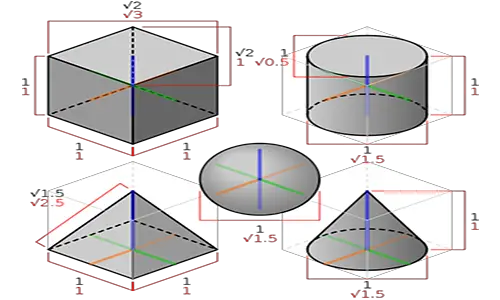An object perceived by a human being is summed up and identified by the brain after considering the properties of the object. The basic properties are the colour, the texture and material of the object. A coke can is red, smooth and made of tin. A spoon is silver, smooth and made of metal.
In addition to colour, texture and material used, the brain perceives the shape of the object. The human brain tends to break down objects into familiar shapes in order to understand them. Psychologists call these shapes geons. They include cones and spheres.
DEFINITION: The external boundary of an object is called its shape. On paper shapes are two dimensional. Objects are three dimensional and are defined by the two dimensional shape that most closely corresponds to the outer boundary of the object.
DIMENSIONS: In geometry the basic shapes are the point, line, plane and solid shape. A point is considered to have zero dimensions, the line – one dimension, a plane or plane figure – two dimensions and a solid shape –three dimensions.
CLASSIFICATIONS: Shapes are classified into those composed of straight line segments and circular shapes. Circular shapes are further sub divided into shapes made of circular arcs and those not having circular arcs.
POLYGONS: Polygons are plane figures composed of straight line segments. They are classified according to the number of sides they have. Starting with three sides and continuing serially up to ten sides they are named, triangle, quadrilateral, pentagon, hexagon, heptagon, octagon, nonagon and decagon. Geometrical terms for figures having more than ten sides also exist.
TRIANGLES: Triangles are three sided polygons. Triangles are further classified into different types based on the length of the sides and the degree of the angles. An equilateral triangle has all three sides and angles equal. A scalene triangle is the exact opposite, all sides and angles measure differently. An isosceles triangle has two equal sides and angles.
QUADRILATERALS: These are four sided polygons. They include – on the basis of equality of sides, angles and diagonals – squares, rectangles, rhombi and trapezoids. A square has all sides and angles equal. The opposite sides are parallel. A rhombus, like a square has all sides equal. The opposite angles are equal and the opposite sides are parallel. Unlike the square, the angles are not right angles. A rectangle has opposite sides and angles equal and parallel. The definition of a trapezium and a trapezoid differ depending on the country of origin. In the UK a trapezoid has no parallel sides. A trapezoid is called a trapezium in the US. A British trapezium has one pair of parallel sides, but the American trapezium has no parallel sides. A kite has two pairs of equal sides adjacent to each other.
CIRCULAR ARC FIGURES: A circle is best defined as a figure where all points on the boundary are at an equal distance from the centre. The boundary is called the circumference. A segment of the circumference is called an arc. Figures having circular arcs include semi circles, crescents and the shape based on the Native American weapon, the tomahawk. Non circular arc figures the heart shape and the oval.
SOLID SHAPES: These are the three dimensional versions of plane figures. Dice are cubes. They have six faces, all squares. A toothpaste carton is a cuboid, four faces are rectangles and two are square. A cylinder is basically a rolled up rectangle with circles on either end. The Great Pyramids of Egypt are square bases with triangles towering upward from each side, and meeting at the apex. A pyramid can also have a triangular or a pentagonal base.
TRIVIA: The swastika is an irregular icosagon (20 sided figure), the Star of David is a hexagram and the Star of Lakshmi is an octagram (8 sided star).
QUESTION: The letters b and p denote different sounds. Are they the same shape? They are congruent and also similar. Will this logic convince a teacher that bag can as well be spelt pag?











Leave a Reply